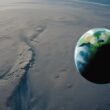When you see Earth from the Moon, it appears as a vibrant blue and white sphere, contrasting sharply with the Moon’s dull gray surface. You’ll notice oceans covering much of the planet, swirling white clouds, and varied landmasses with distinct continents. Earth goes through phases, similar to the Moon’s but in reverse, and atmospheric effects soften its edges and create a blue tint. This unique view reveals Earth’s dynamic nature and highlights details you won’t find elsewhere.
The Visual Contrast Between Earth and the Moon
Although both Earth and the Moon share the same celestial neighborhood, their visual appearances differ markedly when viewed from space.
You’ll notice Earth’s surface glows with vibrant blues, whites, and greens, reflecting its atmosphere, oceans, and vegetation. In contrast, the Moon appears as a dull, gray sphere, its surface covered with craters and rocky plains.
Earth’s brightness and color variety stand out sharply against the Moon’s muted tones. This contrast highlights the dynamic, life-supporting nature of Earth compared to the stark, lifeless environment of the Moon, shaping your perception of these neighboring worlds.
Colors and Features Visible From Lunar Orbit
When you observe Earth from lunar orbit, you can see a range of colors and features that illustrate the planet’s diverse environments.
The vibrant blues of the oceans contrast sharply with the white swirls of clouds, while green and brown landmasses reveal varying terrains.
Some key visible features include:
- Vast ocean expanses that cover about 70% of the surface, reflecting sunlight.
- Large cloud systems indicating weather patterns and atmospheric activity.
- Distinct continents and mountain ranges showing Earth’s geological diversity.
This view highlights Earth’s dynamic nature, offering a unique perspective unavailable from the lunar surface itself.
The Phases of Earth as Seen From the Moon
Because Earth and the Moon orbit around a common center of gravity, you can observe Earth going through distinct phases when viewed from the lunar surface or orbit.
These phases mirror the Moon’s phases seen from Earth but in reverse order. As the Moon rotates, Earth appears to wax and wane, shifting from full Earth—fully illuminated—to new Earth, where the side facing you is dark.
This cyclical pattern occurs over about 29.5 days, offering a dynamic view of Earth’s sunlit portion. Understanding these phases helps you appreciate the orbital mechanics shaping our shared celestial dance.
Atmospheric Effects on Earth’s Appearance
Since Earth’s atmosphere scatters and absorbs sunlight in different ways, it greatly influences how you see the planet from the Moon. The atmospheric effects alter Earth’s colors and clarity, shaping your visual experience.
Key factors include:
- Rayleigh scattering, which causes the blue tint by dispersing shorter wavelengths of light.
- Clouds reflecting sunlight, creating bright white patches that contrast with oceans and land.
- Atmospheric haze that softens details near the horizon, blending edges and reducing sharpness.
These elements combine dynamically, so Earth’s appearance shifts subtly as you observe it from the lunar vantage point.
Emotional Impact of Viewing Earth From Afar
Although you observe Earth as a distant sphere from the Moon, the sight often evokes a profound emotional response.
Seeing your home from afar highlights its fragility and unity, stirring feelings of awe and responsibility. You may experience a renewed appreciation for Earth’s delicate ecosystems and the freedom it offers life. This perspective can inspire a deeper commitment to protect the planet and cherish its resources.
Viewing Earth from the Moon also emphasizes its isolation in the vast cosmos, reminding you how interconnected and dependent all living beings are on this single, shared environment.
Frequently Asked Questions
How Long Does It Take to Travel From the Moon to Earth?
It takes you about three days to travel from the Moon to Earth. You’ll feel the vastness of space, but freedom drives you forward, pushing you closer to home and the life waiting for you below.
What Equipment Do Astronauts Use to Photograph Earth From the Moon?
You’ll use specially modified Hasselblad cameras with large lenses to capture Earth’s beauty from the Moon. These rugged, manual cameras let you seize stunning, high-resolution images despite harsh space conditions and zero gravity.
Can Astronauts See Weather Patterns Like Hurricanes From the Moon?
Yes, you can see large weather patterns like hurricanes from the Moon because they’re massive and distinct. You won’t catch every detail, but those swirling storms stand out clearly against Earth’s surface.
How Does Earth’s Gravity Affect Astronauts on the Moon?
Earth’s gravity barely affects you on the moon because you’re much farther away. You experience the moon’s weaker gravity, so you move lighter and freer, making your every step feel like a bounding leap rather than a heavy stomp.
Do Astronauts Experience Any Health Effects From Viewing Earth in Space?
You don’t experience direct health effects from viewing Earth in space, but the awe can boost your mental well-being. That inspiring perspective often strengthens your sense of freedom and connection beyond daily confines.






